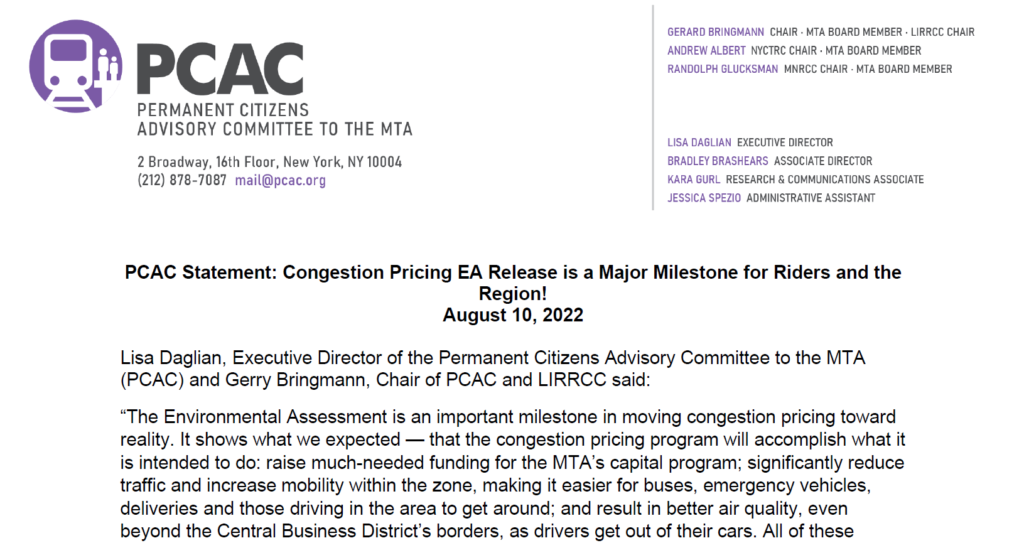Lisa Daglian, Executive Director of the Permanent Citizens Advisory Committee to the MTA (PCAC) and Gerry Bringmann, Chair of PCAC and LIRRCC said:
“The Environmental Assessment is an important milestone in moving congestion pricing toward reality. It shows what we expected — that the congestion pricing program will accomplish what it is intended to do: raise much-needed funding for the MTA’s capital program; significantly reduce traffic and increase mobility within the zone, making it easier for buses, emergency vehicles, deliveries and those driving in the area to get around; and result in better air quality, even beyond the Central Business District’s borders, as drivers get out of their cars. All of these critical improvements will come with few negative impacts, and the upsides for riders and the region as a whole far outweigh the downsides for drivers. The importance of the money that congestion pricing will bring in cannot be overstated: it is critical to the future of the region’s transit system. It will pay for signals, tracks, accessibility projects, new rolling stock, security upgrades including track intrusion detection equipment and new CCTVs, and essential state of good repair work to keep trains and buses working safely and reliably for all riders. The scenarios the EA includes show the extent of modeling the MTA and its partners went through to consider potential impacts – and that they listened to the thousands of people who weighed in during the first round of public hearings.
“Getting it right is key as the MTA and its partners seek to implement for the first time in the United States a program which has proved to be so successful and beneficial in Singapore, Milan and Stockholm. So too is ensuring successful and expedient implementation with limited exemptions to maximize benefits and minimize disruption and fees. Riders will be thankful for the $15 billion, when bonded, that congestion pricing will bring. The findings of the EA confirm what we already know: the majority of people who travel into the Central Business District get there using transit. The funds from congestion pricing will help get them there and help bring more riders out of cars and onto transit. It is the perfect time to ensure sufficient service will be running with good frequency, and to extend and expand the discount programs the MTA has in place – 10% off monthly tickets and 20% off 20-trip tickets for LIRR and Metro-North riders, along with the expanded daily off peak CityTicket program – and, we hope, Freedom Ticket that includes transfers to buses and subways. Other incentives like fare capping with OMNY and expanding eligibility for Fair Fares will also be key. Ensuring good first mile/last mile connections are in place is also important, including more secure bike parking around train and subway stations.
“The reward is a transit system that will work for everyone for decades to come. We look forward to a Finding of No Significant Impact (FONSI) that will allow the project to go forward — bringing transit riders more secure future funding, with the much-needed added effects of improved air quality, crucial as we fight climate change, and reduced gridlock around the region. Congestion pricing is the future, and the time for the future is now.”
